Bill de Blasio
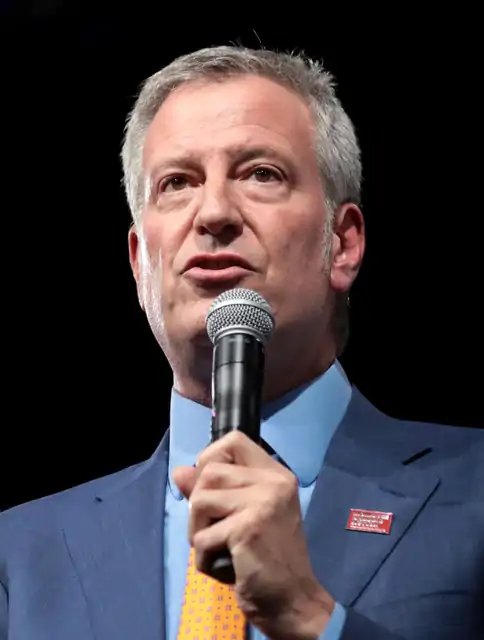
Bill de Blasio

Bill de Blasio | |
|---|---|
| 109th Mayor of New York City | |
| Assumed office January 1, 2014 | |
| Preceded by | Michael Bloomberg |
| 3rd Public Advocate of New York City | |
| In office January 1, 2010 – December 31, 2013 | |
| Preceded by | Betsy Gotbaum |
| Succeeded by | Letitia James |
| Member of the New York City Council from the 39th district | |
| In office January 1, 2002 – December 31, 2009 | |
| Preceded by | Stephen DiBrienza |
| Succeeded by | Brad Lander |
| Personal details | |
| Born | Warren Wilhelm Jr. (1961-05-08)May 8, 1961 Manhattan, New York City, U.S. |
| Political party | Democratic |
| Spouse(s) | Chirlane McCray (m. 1994) |
| Children | 2 |
| Residence | Gracie Mansion (Official) |
| Education | New York University (BA) Columbia University (MIA) |
| Signature | |
| Website | nyc.gov/mayor [179](government) billdeblasio.com [180](personal) |
Bill de Blasio (/dɪˈblɑːzioʊ/; born Warren Wilhelm Jr.; May 8, 1961) is an American politician who has served as the 109th mayor of New York City since 2014. He was New York City's public advocate from 2010 to 2013. He was a candidate for President of the United States in the 2020 election.
Born in Manhattan, de Blasio graduated from New York University and Columbia University before a brief stint as a campaign manager for Charles Rangel and Hillary Clinton. He started his career as an elected official on the New York City Council, representing the 39th district in Brooklyn from 2002 to 2009. His tenure as public advocate saw a reformation of various educational, housing, and campaign finance policies. He was elected mayor of New York City in 2013 and reelected in 2017.
De Blasio policy initiatives have included new de-escalation training for officers, reduced prosecutions for cannabis possession, implementation the use of police body cameras, and ending of the post-9/11 surveillance program of Muslim residents. In his first term, he implemented free universal Pre-K in the city. He has advocated for a millionaire tax though the proposal was rejected by New York governor Andrew Cuomo.
De Blasio has called attention to what he calls stark economic inequality in New York City, which he described as a "tale of two cities" during his first campaign. He has supported socially liberal and progressive discourse on the city's economy, urban planning, public education, police relations, and privatization. De Blasio has had mixed approval ratings among New Yorkers, which commentators have attributed to controversies over his administration's management of city affairs.[2][3][4] De Blasio ran in the Democratic primaries for the 2020 presidential election. Despite a well-received initial debate performance,[5] de Blasio registered consistently low poll numbers and failed to qualify for the third round of primary debates.[6] He suspended his campaign on September 20, 2019.
Bill de Blasio | |
|---|---|
| 109th Mayor of New York City | |
| Assumed office January 1, 2014 | |
| Preceded by | Michael Bloomberg |
| 3rd Public Advocate of New York City | |
| In office January 1, 2010 – December 31, 2013 | |
| Preceded by | Betsy Gotbaum |
| Succeeded by | Letitia James |
| Member of the New York City Council from the 39th district | |
| In office January 1, 2002 – December 31, 2009 | |
| Preceded by | Stephen DiBrienza |
| Succeeded by | Brad Lander |
| Personal details | |
| Born | Warren Wilhelm Jr. (1961-05-08)May 8, 1961 Manhattan, New York City, U.S. |
| Political party | Democratic |
| Spouse(s) | Chirlane McCray (m. 1994) |
| Children | 2 |
| Residence | Gracie Mansion (Official) |
| Education | New York University (BA) Columbia University (MIA) |
| Signature | |
| Website | nyc.gov/mayor [179](government) billdeblasio.com [180](personal) |
Early life and career
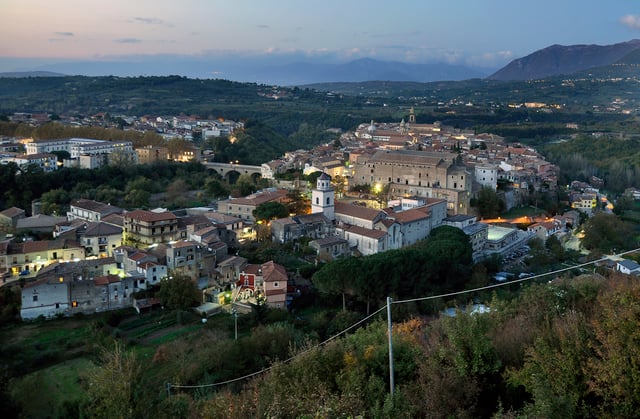
Bill de Blasio's maternal grandfather came from the Italian city of Sant'Agata de' Goti.
Bill de Blasio was born on May 8, 1961, in Manhattan's Doctors Hospital.[7] He is the third son of Maria Angela (née de Blasio; 1917–2007) and Warren Wilhelm (1917–1979).[8] De Blasio has two brothers, Steven and Donald, thirteen and eight years his senior, respectively.[7] His mother was of Italian heritage, and his father was of German, English, French, and Scots-Irish ancestry.[9][10][11] His paternal grandparents were Donald Wilhelm, of Ohio, and Nina (Warren), who was born in Iowa.[12][13] His maternal grandfather, Giovanni, was from Sant'Agata de' Goti, Benevento, and his grandmother, Anna (née Briganti), was from Grassano, Matera.[14] His paternal uncle, Donald George Wilhelm Jr., worked for the Central Intelligence Agency in Iran and secretly wrote the last Shah of Iran, Mohammad Reza Pahlavi's, memoir.[15]
Maria de Blasio attended Smith College, served in the Office of War Information during World War II and authored The Other Italy: The Italian Resistance in World War II (1988).[16] His father, a Yale University graduate, worked as a contributing editor at Time Magazine and also served in World War II. He enlisted in the U.S. Army in 1942 and was sent to the Pacific War. During the 82-day Battle of Okinawa, a grenade detonated below his left foot, leaving him with an avulsion fracture. After receiving a Purple Heart,[17] he married Maria in 1945, and became a budget analyst for the federal government. During the 1950s, at the height of the Red Scare, both Maria and Warren were accused of having a "sympathetic interest in Communism".
In 1966, the family moved to Cambridge, Massachusetts, where de Blasio began kindergarten.[18] Though originally named Warren Wilhelm Jr., he was called "Bill" or "Billy" growing up.[19] His father became a heavy drinker, causing the family emotional distress during this time. His parents divorced when he was seven and he and his brother Donald were raised by Maria and her extended family. Of his early childhood, de Blasio said, "my mother and father broke up very early on in the time I came along, and I was brought up by my mother's family—that's the bottom line—the de Blasio family."[19] His father committed suicide while suffering from incurable lung cancer when Bill was 18.[20] De Blasio graduated from Cambridge Rindge and Latin School in 1979, where he served in student government and was known to peers as "Senator Provolone".[1] When he was 22, he adopted his mother's surname because his father was "largely absent" and he wanted to embrace his Italian heritage.[22] He hyphenated it to Warren de Blasio-Wilhelm in 1983, and formally adopted the name Bill de Blasio in December 2001.[22] He received a Bachelor of Arts from New York University in metropolitan studies, a program in urban studies, and a Master of International Affairs from Columbia University's School of International and Public Affairs.[23] He is a 1981 Harry S. Truman Scholar.[24]
Campaign manager
De Blasio's first job was part of the Urban Fellows Program for the New York City Department of Juvenile Justice in 1984.[25][26] In 1987, shortly after completing graduate school at Columbia, de Blasio was hired to work as a political organizer by the Quixote Center in Maryland. In 1988, he traveled with the Quixote Center to Nicaragua for 10 days to help distribute food and medicine during the Nicaraguan Revolution. De Blasio was an ardent supporter of the ruling socialist government, the Sandinista National Liberation Front, which was at that time opposed by the Reagan administration.[26] After returning from Nicaragua, de Blasio moved to New York City, where he worked for a nonprofit organization focused on improving health care in Central America.[26] He continued to support the Sandinistas in his spare time, joining a group called the Nicaragua Solidarity Network of Greater New York, which held meetings and fundraisers for the Sandinista political party.[26] De Blasio's introduction to city politics came in 1989, when he worked as a volunteer coordinator for David Dinkins' mayoral campaign.[27] Following the campaign, de Blasio was an aide in City Hall.[28] In 1990, he described himself as an advocate for democratic socialism when asked about his goals for society.[26]
U.S. Representative Charles Rangel tapped de Blasio to be his campaign manager for his successful 1994 re-election bid.[29] In 1997, he was appointed to serve as the regional director for the United States Department of Housing and Urban Development (HUD) for New York and New Jersey under the administration of President Bill Clinton. As the tri-state region's highest-ranking HUD official, de Blasio led a small executive staff and took part in outreach to residents of substandard housing.[30][31] In 1999, he was elected to be a school board member for Brooklyn School District 15.[32] The following year, he served as campaign manager for Hillary Clinton's successful United States Senate bid.[32]
New York City Council (2002–2009)
Elections
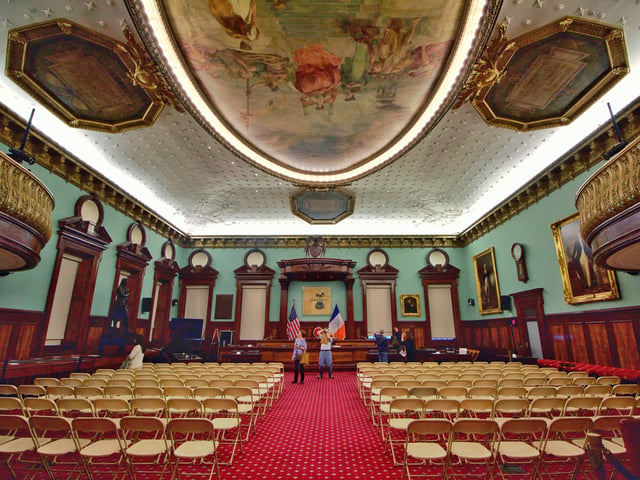
The New York City Council chambers, where de Blasio served from 2002 to 2009.
In 2001, de Blasio ran for the New York City Council's 39th district, which includes the Brooklyn neighborhoods of Borough Park, Carroll Gardens, Cobble Hill, Gowanus, Kensington, Park Slope, and Windsor Terrace. He won the crowded primary election with 32% of the vote.[33] In the general election, he defeated Republican Robert A. Bell, 71% to 17%.[34] He was reelected with 72% of the vote in 2002[35] and with 83% of the vote in 2005.[36]
Tenure
On the City Council, de Blasio passed legislation to prevent landlord discrimination against tenants who hold federal housing subsidy vouchers, and helped pass the HIV/AIDS Housing Services Law, improving housing services for low-income New Yorkers living with HIV/AIDS.[37][38] As head of the city council's General Welfare Committee, de Blasio helped pass the Gender-Based Discrimination Protection Law to protect transgender New Yorkers, and passed the Domestic Partnership Recognition Law to ensure that same-sex couples in a legal partnership could enjoy the same legal benefits as heterosexual couples in New York City.[39] During his tenure, the General Welfare Committee also passed the Benefits Translation for Immigrants Law, which helped non-English speakers receive free language-assistance services when accessing government programs.[40] He served on the education, environmental protection, finance, and technology committees and chaired the general welfare committee.[41][42][43][44][45]
New York City Public Advocate (2010–2013)
Election
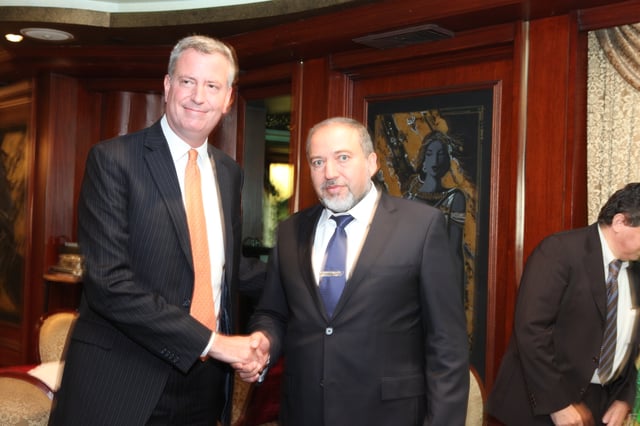
Bill de Blasio and Israeli Foreign Minister Avigdor Lieberman in 2012
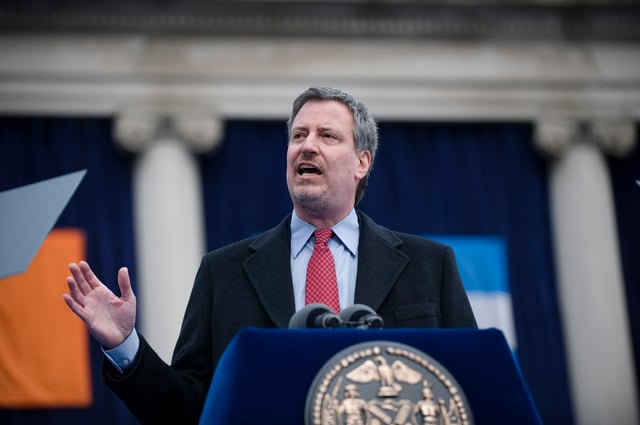
De Blasio speaking at his January 2010 inauguration
In November 2008, de Blasio announced his candidacy for New York City Public Advocate, entering a crowded field of candidates vying for the Democratic nomination that included former Public Advocate Mark J. Green. The New York Times endorsed de Blasio, praising his efforts to improve public schools and "[help] many less-fortunate New Yorkers with food stamps, housing, and children's health" as a councilmember. The paper declared de Blasio the best candidate for the job "because he has shown that he can work well with Mayor Bloomberg when it makes sense to do so while vehemently and eloquently opposing him when justified."[46] His candidacy was endorsed by then Public Advocate Betsy Gotbaum, former Mayor Ed Koch, former Governor Mario Cuomo, and Reverend Al Sharpton.[47]
On September 15, 2009, de Blasio finished first in the Democratic primary, garnering 33% of the vote.[48] He won the runoff primary election on September 29, defeating Green, 62% to 38%.[49] In the November 3 general election, de Blasio defeated Republican Alex Zablocki, 78% to 18%.[50][51] De Blasio was inaugurated as New York City's third Public Advocate on January 1, 2010. In his inauguration speech he criticized the Bloomberg administration, especially its homelessness and education policies.[52]
Education
As public advocate, de Blasio repeatedly criticized Bloomberg's education policies. He called for Cathie Black, Bloomberg's nominee for New York City Schools Chancellor, to take part in public forums and criticized her for sending her own children to private schools.[53][54] In March 2010, he spoke against an MTA proposal to eliminate free MetroCards for students, arguing the measure would take a significant toll on school attendance.[55] Three months later, he voiced opposition to the mayor's proposed budget containing more than $34 million in cuts to childcare services.[56] In June 2011, de Blasio outlined a plan to improve the process of school co-location, by which multiple schools are housed in one building. His study found community input was often ignored by the city's Department of Education, resulting in top-down decisions made without sufficient regard for negative impacts. He outlined eight solutions to improve the process and incorporate community opinion into the decision-making process.[57]
The same month, he also criticized a Bloomberg administration proposal to lay off more than 4,600 teachers to balance the city's budget; de Blasio organized parents and communities against the proposed cuts and staged a last-minute call-a-thon. Bloomberg restored the funding, agreeing to find savings elsewhere in the budget.[58] During his mayoral campaign, de Blasio outlined a plan to raise taxes on residents earning more than $500,000 a year to pay for universal pre-kindergarten programs and to expand after-school programs at middle schools.[59][60] He also pledged to invest $150 million annually into the City University of New York to lower tuition and improve degree programs.[60] In September 2013, de Blasio voiced his opposition to charter schools, maintaining that their funding saps resources from classes like art, physical education and after-school programs. He outlined a plan to discontinue the policy of offering rent-free space to the city's 183 charter schools and to place a moratorium on the co-location of charter schools in public school buildings. He said, "I won't favor charters. Our central focus is traditional public schools."[61]
Housing
In June 2010, de Blasio opposed a New York City Housing Authority decision to cut the number of Section 8 vouchers issued to low-income New Yorkers. The cut was announced after the NYCHA discovered it could not pay for approximately 2,600 vouchers that had already been issued.[62] Two months later, he launched an online "NYC's Worst Landlords Watchlist" to track landlords who failed to repair dangerous living conditions. The list drew widespread media coverage and highlighted hundreds of landlords across the city. "We want these landlords to feel like they're being watched," de Blasio told the New York Daily News. "We need to shine a light on these folks to shame them into action."[63]
Affordable housing
Atlantic Avenue, in the East New York neighborhood of Brooklyn, which has been scarred by decades of poverty and crime, was the first test and focus of de Blasio's strategy on affordable housing, one of the policy initiatives central to his platform of reducing inequality. Since 2012, city planners have been working to bring residents to forums to consult on the process. The plan is to "invite developers to build up local streets in exchange for more units of affordable housing." They will invest in new trees, parks, sidewalks, schools, shops, and restaurants that will lead to better services.[64]
Campaign finance
De Blasio has been a vocal opponent of Citizens United, the January 2010 U.S. Supreme Court decision that overturned parts of the 2002 McCain-Feingold Bipartisan Campaign Reform Act. He argued that "corporations should not be allowed to buy elections" and launched a national campaign by elected officials to reverse the decision's effects.[65]
Mayor of New York City (2014–present)
2013 election
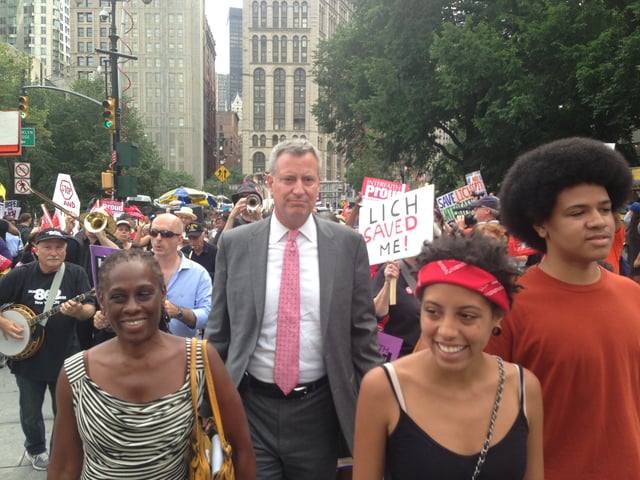
Bill de Blasio with his wife, Chirlane (left), and two children at a rally in New York City in 2013
On January 27, 2013, de Blasio announced his candidacy for mayor of New York City in the fall election.[66][67] The Democratic primary race included nine candidates, among them Council Speaker Christine Quinn, former U.S. Representative Anthony Weiner, and former New York City Comptroller and 2009 mayoral nominee Bill Thompson.[68][69] After Weiner joined the race in April, early polls showed de Blasio in fourth or fifth among the candidates.[70] Despite his poor starting position, de Blasio gained the endorsements of major Democratic clubs, such as the Barack Obama Democratic Club of Upper Manhattan, and New York City's largest trade union, SEIU Local 1199. Celebrities such as Alec Baldwin and Sarah Jessica Parker endorsed him, as did prominent politicians such as former Vermont Governor Howard Dean and U.S. Congresswoman Yvette Clarke.[71][72][73] By August, singer Harry Belafonte and actress Susan Sarandon had endorsed de Blasio.[74]
De Blasio gained media attention during the campaign when he and a dozen others, including city councillor Stephen Levin, were arrested while protesting the closing of Long Island College Hospital.[75] De Blasio and Levin were released a few hours later with disorderly conduct summonses. Fellow Democratic mayoral hopefuls Weiner and City Comptroller John Liu were also at the protest but were not arrested.[76]
In the first week of August, the de Blasio campaign released a television advertisement featuring de Blasio's then-15-year-old son, Dante, talking about his father's plans to "'really break from the Bloomberg years.'"[77][78] TIME called it "The Ad That Won the New York Mayor's Race," noting that after it ran, "de Blasio built a steady lead that he never relinquished."[77] Quinn was attacked by a number of groups including NYCLASS with their "Anybody But Quinn" campaign, allowing de Blasio to move up in the polls. By mid-August he emerged as the new leader among the Democrats.[79][80] He reached 43% in a Quinnipiac poll released a week before the primary.[81] Preliminary results of the September 11 primary showed de Blasio with 40.1% of the votes, slightly more than the 40% needed to avoid a runoff.[82]
On September 16, second-place finisher Bill Thompson conceded, citing the unlikelihood of winning a runoff even if uncounted absentee and military ballots pushed de Blasio below the 40% threshold. Thompson's withdrawal made de Blasio the Democratic nominee against Republican Joe Lhota in the general election.[83] Exit polls showed that the issue that most aided de Blasio's primary victory was his unequivocal opposition to "stop and frisk."[84] After the primary, de Blasio was announced as the nominee of the Working Families Party.[85] In the general election, he defeated Lhota in a landslide with 72.2% of the vote.[86] Voter turnout for the election set a new record low of only 24% of registered voters, which The New York Times attributed to the expectation of a landslide in the heavily Democratic city.[87] The campaign finance activities of the de Blasio 2013 committee reportedly became the subject of a federal corruption investigation led by U.S. Attorney Preet Bharara. Other government authorities were also involved in investigations, some of which reportedly overlapped, including whether campaign donors received preferential treatment from City Hall.[88] The investigation ended in March 2017 with no charges.
2017 election
In 2017, de Blasio won reelection to a second term with 66.5% of the vote, defeating Republican assemblywoman Nicole Malliotakis.[89]
Tenure

De Blasio and Indian Prime Minister Narendra Modi in New York on September 26, 2014
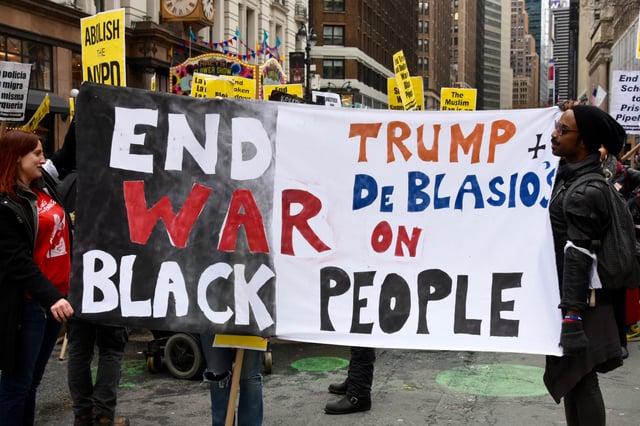
No NYC Hypocrisy rally in April 2017
De Blasio was sworn into office on January 1, 2014, by former President Bill Clinton. In his inaugural address, he reiterated his campaign pledge to address "economic and social inequalities" within the city.[90] The New York Times noted that "The elevation of an assertive, tax-the-rich liberal to the nation's most prominent municipal office has fanned hopes that hot-button causes like universal prekindergarten and low-wage worker benefits... could be aided by the imprimatur of being proved workable in New York."[91]
In the first weeks of de Blasio's mayoralty, New York City was struck by a series of snowstorms.[92] De Blasio was criticized by Upper East Side residents who said efforts to clear the snow seemed to be lagging in their neighborhood.[93] De Blasio apologized the next day, saying that "more could have been done to serve the Upper East Side."[93] On February 13, heavy snowstorms again hit the East Coast. Under instructions from De Blasio and School Chancellor Carmen Fariña, the city's public schools were kept open, a decision criticized by teacher unions, parents and the media as up to 9.5 inches of snow fell that day.[94] By the middle of February, the city had added $35 million to the Sanitation Department's budget for snow removal.[92]
In July 2014, de Blasio signed a bill that created municipal identification cards for all residents regardless of immigration status, helping them secure access to city services.[95] Homeless New Yorkers are also eligible to obtain the IDNYC cards so long as they register a "care of" address. The IDNYC card program was launched January 1, 2015.[96]
In January 2019, de Blasio and Secretary of Housing and Urban Development Ben Carson reached an agreement to change the operations of the New York City Housing Authority. The agreement created "specific requirements and milestones to address the serious health and safety hazards at NYCHA properties, including lead-based paint, mold, heat, vermin, among others".[97]
NYPD relations
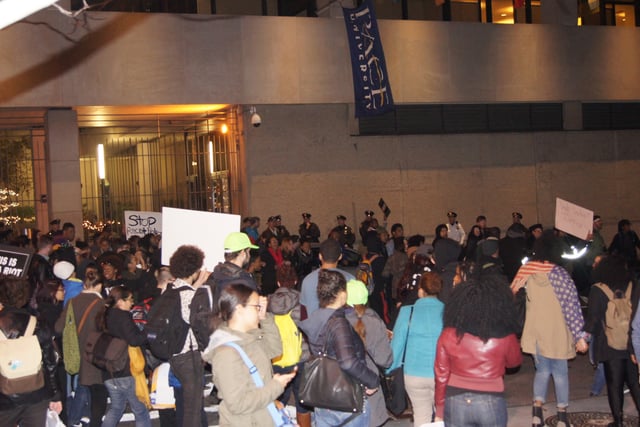
New Yorkers demonstrating against police brutality at Pace University in November 2014
Opposition to the NYPD's "stop and frisk" policy was a centerpiece of De Blasio's campaign.[102] The practice had been challenged by civil rights groups in federal court, where it was ruled unconstitutional in 2013. The federal appeal of this decision filed by the Bloomberg administration was dropped by de Blasio upon taking office. He vowed to settle cases with claimants who had ongoing litigation against the police for stop and frisk arrests. The NYPD union appealed the decision without de Blasio's support, and was rejected.[103]
De Blasio selected Bill Bratton for New York City Police Commissioner, a position he had held under Mayor Rudy Giuliani. Bratton, who introduced stop and frisk under Giuliani, promised it would be used "legally, respectfully" and less frequently.[104][105] Some de Blasio supporters were disappointed with Bratton's appointment.[106]
In February 2014, de Blasio came under criticism for calling the police shortly after one of his supporters was detained by police. Pastor Bishop Orlando Findlayter—the founder of the New Hope Christian Fellowship Church, and a friend of de Blasio—was pulled over for failing to signal on a left turn. Findlayter was then detained by police on outstanding warrants and driving with a suspended license.[107] De Blasio is alleged to have called the police on Findlayter's behalf. Findlayter was released shortly thereafter. In a press conference, de Blasio told reporters that while he had called the police to make an inquiry regarding Findlayter's arrest he did not ask the police to release him.[108] A spokesperson for the mayor said that de Blasio's call occurred after the police already had decided to release Findlayter.[107] While both the police and City Hall denied that De Blasio asked for preferential treatment, City Comptroller Scott M. Stringer said De Blasio's behavior was problematic because "the mayor shouldn't be involved in any way about somebody's arrest."[109]
On December 3, 2014, following a grand jury decision not to indict NYPD officer Daniel Pantaleo in the death of Eric Garner, de Blasio said in a speech that he and his African American wife, Chirlane McCray, had had many conversations[110] with their biracial son about taking "special care in any encounters he has with the police officers who are there to protect him."[111] De Blasio also "offered qualified support for protesters after the grand jury decision not to charge the officer involved in the chokehold death of Eric Garner in New York City".[112]
After New York City police officers Wenjian Liu and Rafael Ramos were killed in an ambush in December 2014, "cops and union leaders publicly rebuked [de Blasio], arguing [that] his earlier remarks had stoked anti-police sentiment."[113] When de Blasio eulogized the two fallen officers, hundreds of their fellow police officers turned their backs on him.[112]
Following the murder of New York City police officer Miosotis Familia in July 2017, de Blasio received further criticism for not attending Familia's vigil. Many officers again turned their backs on him when he spoke at a service for Familia.[114]
2020 presidential campaign

de Blasio's 2020 presidential campaign logo
On May 16, 2019, de Blasio announced that he would seek the Democratic nomination for president after releasing a YouTube video in which he said, "I’m Bill de Blasio, and I’m running for president because it’s time we put working people first."[115] He is the first incumbent mayor of New York City to run for president since John Lindsay, who ran for the Democratic nomination in 1972.[116] His candidacy was described as a "long shot" by The New York Times, referring to his low national poll numbers and inconsistent approval ratings in New York City*.*[117][118]
In September 2019, The New York Times reported that de Blasio said it would be “tough to conceive” continuing his campaign if he didn't qualify for the third Democratic debate—after qualifying for the first two—by October 1, 2019.[119] On September 20, de Blasio ended his presidential campaign[120][121]
Political positions
Transportation
In 2014, de Blasio released a report dedicated to "better transit for New York City." Some of the ideas brought up in the report were to rebuild Penn Station/Madison Square Garden, create more bus rapid transit routes,[122] and a "Vision Zero" initiative to reduce traffic-related deaths in the city.[123]
The "Vision Zero" initiative, inspired by a successful Swedish plan, saw a gradual decrease in pedestrian fatalities, from 299 in 2013 to 200 in 2018.[124] However, in 2019 there has been an increase in cyclist deaths, and de Blasio has discussed several proposals to combat cyclist deaths, including a $58.4 million plan[125] and requiring cyclists to wear helmets and acquire licenses to operate a bicycle.[126]
While the de Blasio administration planned on increasing the rate at which bicycle racks were added in the city, the annual rate has instead fallen by 42 percent compared to the Bloomberg administration, reaching a new average of 1,633 new racks per year. Jon Orcutt, a spokesman for Bike New York, said "Everybody's talking about Citi Bikes and scooters but it's the humble bike rack that needs more attention."[127]
Tech and innovation
When de Blasio appointed Minerva Tantoco[128] as the city's chief technology officer in fall 2014, he said her goal would be to "develop and implement a coordinated strategy for technology and innovation, for how this city as a whole is going to approach the role of technology in our everyday lives, in our economy, in our schools, in our civic participation."[129]
Along with Governor Cuomo, de Blasio supported moving Amazon's headquarters to Long Island City in the Amazon HQ2 search, and worked with Cuomo to develop a benefits package from New York City and State funds totaling $2.988 billion.[130] In November 2018, Long Island City was selected as one of two sites for HQ2, along with Crystal City in Virginia, directly outside of Washington, D.C.[130] Long Island City's selection as a site for Amazon's HQ2 was controversial before and after it happened, and was protested by local residents, community organizations, and politicians. After receiving pushback, Amazon withdrew its plans to open HQ2 in Long Island City on February 14, 2019.[131] De Blasio later criticized Amazon's decision.[132]
Affordable housing
A key aim of de Blasio's tenure has been to build more affordable housing, with a goal of 200,000 units.[133] His plan passed the City Council,[134] but has been controversial. Groups like New York Communities for Change have come out against aspects of the plan, arguing that it promotes gentrification.[135] Relatedly, in April 2017 the state government renewed the 421-a tax abatement program after unions and developers made a deal on wages in qualifying construction projects.[136]
Charter schools
De Blasio's decision to deny the use of public space to several New York City charter schools provoked controversy among advocates of school vouchers.[137] The decision overturned a Bloomberg administration arrangement that allowed for "co-locations", where charter schools were housed in public school buildings.[138] De Blasio also revoked $200 million of capital funding earmarked for charter schools.[139] The New York Times emphasized that de Blasio approved 14 charter school co-locations and denied just three, suggesting that he was being unfairly cast as opposed to charter schools.[140] Approximately two months after the initial decision, the mayor's office announced that it had found space for the three schools. The city would lease three buildings, which were previously used for Catholic schools, from the Archdiocese of New York, and renovate and maintain them. The three charter schools are run by Success Academy Charter Schools.[141]
Universal Pre-K
As mayor, de Blasio's signature initiative was the implementation of Universal Pre-K, the availability of publicly funded pre-kindergarten for all New York City residents.[142][143] He sought to fund the program by increasing taxes on New York City residents earning $500,000 or more.[144] De Blasio's initiative has seen an increase in Universal Pre-K enrollment in New York City through 2015, with over 70% of pre-K expansions happening within the ZIP codes of the city's poorest quartile.[145] In 2017 de Blasio proposed an expansion of the program to "3-K", to include three-year-olds. Preschool for three-year-olds would start in poorer neighborhoods, with the goal of covering the entire city, if the state or federal governments provided funding.[146]
Mohel disclosure rule
In 2015, de Blasio repealed a requirement that mohels inform parents of the risks of metzitzah b'peh, an oral circumcision ritual that was linked to 17 cases of infant herpes, brain damage, and two deaths since 2000.[147][148] The rule was passed by the city's Board of Health in 2012, required parents to sign a consent form, and had been called an infringement on religious freedom by ultra-Orthodox Jewish leaders, who sued the city in federal court[149] and pressed their followers not to comply.[150] After de Blasio installed allies and donors on New York City's Board of Health,[151] a new policy stated that mohels could be banned for life if they tested positive for herpes and the DNA strain matched the infant's, but only after a child has been infected, and not when a mohel tests positive but his DNA strain does not match the infant's.[152] It was revealed that the city did not disclose new infections.[153] Since the change was made, several children have been infected with the disease after undergoing the ritual.[154]
Israel
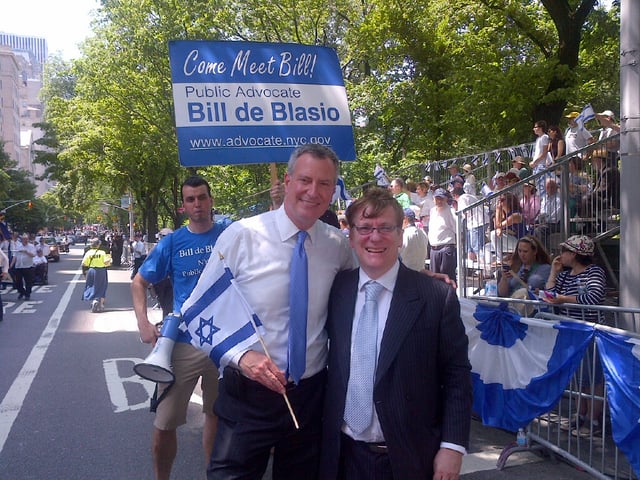
De Blasio at the Celebrate Israel Parade in June 2013
On February 14, 2019, while addressing a rally in New York City about combatting antisemitism, De Blasio said: "Maybe some people don’t realize it, but when they support the BDS movement, they are affronting the right of Israel to exist and that is unacceptable."[155] De Blasio condemned Ilhan Omar's remarks about Israel and pro-Israel lobbyists as "absolutely unacceptable" and "illogical".[156]
9/11 attacks
De Blasio supports the Justice Against Sponsors of Terrorism Act that would allow relatives of victims of the September 11 attacks to sue Saudi Arabia for its government's alleged role in the attacks.[157]
Afghanistan
On June 19, 2019, de Blasio said, "We have to make sure there is a peace settlement in Afghanistan; it obviously has to involve the Taliban. Until that point, I don’t think it’s sensible to take out our troops."[158]
Marijuana legalization
In December 2018, De Blasio announced his support for marijuana legalization in New York City, calling it a "once-in-a-generation opportunity to get a historic issue right for future New Yorkers."[159] He worked with a marijuana task force to produce a report on licensing and regulation, which was released along with a letter of endorsement.[160]
Environmental issues
De Blasio supports the Green New Deal. In April 2019 he announced his support for legislation to ban the construction of glass and steel skyscrapers in New York City, citing environmental concerns and contribution to global warming.[161] De Blasio also criticized the development at Hudson Yards in Manhattan as "examples of the wrong way to do things".[162]
Personal life
De Blasio and his wife, activist and poet Chirlane McCray, met while both were working for Mayor Dinkins' administration and married in 1994.[163] The couple honeymooned in Cuba in violation of a U.S. travel ban.[164] They lived in Park Slope, Brooklyn, before moving into Gracie Mansion,[165] the traditional residence of New York City mayors. They have two children: Dante, a graduate of Brooklyn Technical High School who graduated from Yale University in 2019,[166] and Chiara, a student at Santa Clara University in California.[66][163][167] Chiara addressed her drug use and depression in late December 2013, in a four-minute video the mayor's transition team released.[168]
At 6 ft 5 in (1.96 m), de Blasio is the tallest mayor in New York City's history.[169]
De Blasio, an Italian American, regularly conducts interviews, press conferences, and speeches in Italian.[170][171][172]
Net worth
According to Forbes, De Blasio and his wife have a net worth of $2.5 million.[173]
See also
List of mayors of the largest 50 US cities


